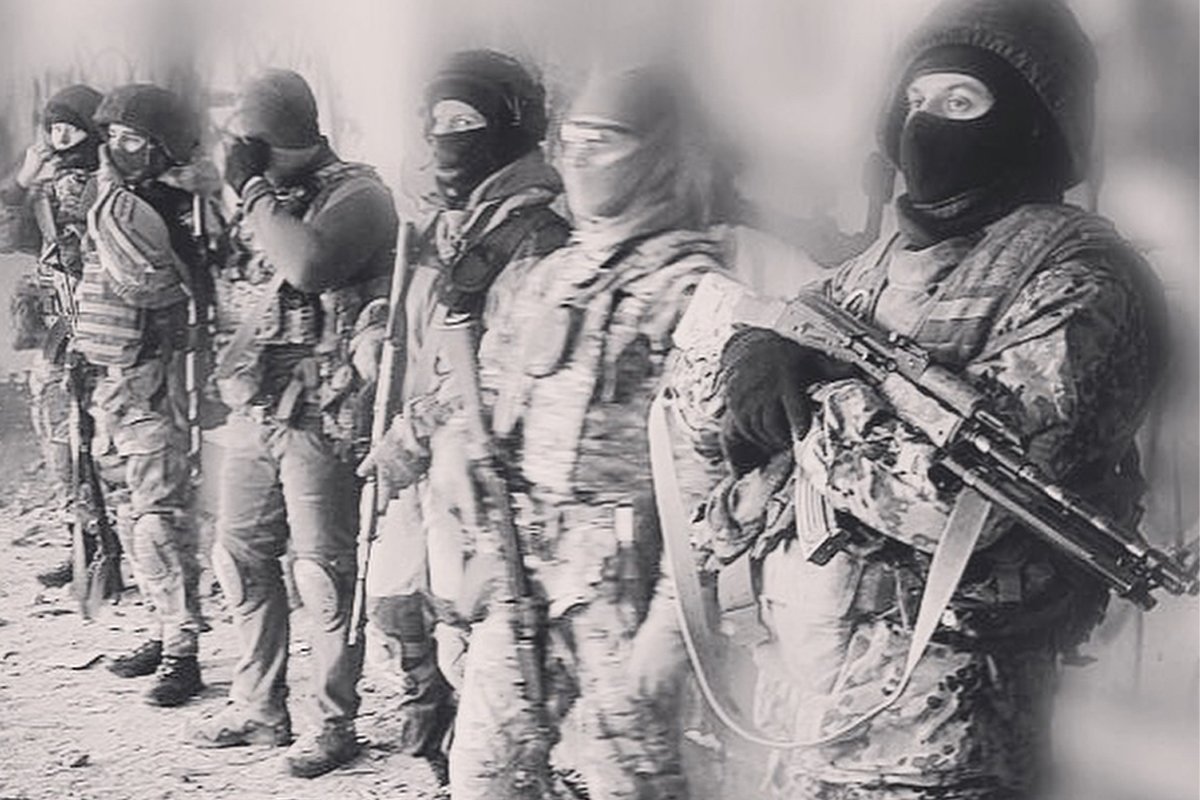
Photo courtesy of Instagram.
With as many as 190,000 Russian troops staged on the border of Ukraine, mercenaries from the Russian-controlled Wagner Group and an off-the-books neo-Nazi reconnaissance unit in the Wagner network began arriving just as US intelligence suggested that covert operatives could conduct a false flag operation to be used by Russia as a pretext to attack.
Although Putin denies any connection between Russia and the Wagner Group, the private security company is believed to be owned by his close friend Yevgeny Prigozhin. An ex-convict and former hot dog vendor, Prigozhin and 12 others have been indicted by the US for meddling in the 2016 election through the Internet Research Agency, dubbed the “Troll Farm.”
The first sign of the Wagner Group operating in the Donbas region of Ukraine came when reports of “little green men” began surfacing in 2014. Masked soldiers in sterile uniforms with modern Russian equipment were photographed working with Russian separatists in the region. According to a new memoir released by former Wagner commander Marat Gabidullin, Wagner was selective in its recruitment program in the beginning, but those standards have slipped as Wagner has hired an increasing number of mercenaries with no prior military combat deployments.
View this post on Instagram
More than half of Wagner’s mercenaries are Russian, with the remaining ranks composed of Moldovans, Ukrainians, Serbs, and Belarusians. The average pay for fighters is $4,600 a month, compared with the average Russian soldier’s pay of $1,200 a month.
Wagner’s recent arrival in Ukraine stirred fears that the group could sow discord, conduct false flag operations, and carry out targeted assassinations. Mercenaries were reported to be in the Donbas region and in the southern Russian city of Krasnodar. Many of the fighters arriving in Ukraine have been redeployed from the Central African Republic, where a United Nations report accused Wagner of killing civilians, looting, and forced disappearances. The Central African Republic is one of Russia’s strongest allies in sub-Saharan Africa.
The contractors were in the 80% rebel-controlled country to assist in Russian-controlled diamond mining operations. In one of the group’s few successes against local militias in the towns of Bria and Ndele, Wagner routed the local insurgents and then reportedly took over where the insurgents left off by levying their own tax on the coffee industry in the area.
View this post on Instagram
In 2018, three Russian journalists arrived in the Central African Republic to shoot a documentary on Wagner. From the moment they arrived, they were under surveillance by local police. While traveling at night, near the village of Sibut, the journalists were killed by what was initially reported as 10 Arabic-speaking robbers. However, none of the journalists’ belongings or equipment was taken. Subsequent investigations have revealed that the driver, who escaped unscathed, had been in direct telephone contact with a local police officer with strong ties to Wagner.
One unit, composed of recruits from a neo-Nazi group in St. Petersburg called Rusich, hinted on social media that it was leaving Africa to return to Ukraine. On Twitter, a member of the group asked if Rusich was heading to Ukraine. The Rusich member replied, “Kharkiv People’s Republic,” an area once controlled by Russian separatists.
Task Force Rusich is designated as a “reconnaissance and sabotage group.” Rusich developed a reputation for brutality in the fighting in the Donbas region. In 2014, Rusich ambushed a Ukrainian column, killing dozens of volunteer fighters. Rusich then mutilated and set fire to the bodies. Photographs of the unit taking selfies amid the carnage circled online and served to fuel the group’s lore. Rusich departed Ukraine in 2015 after the group’s commander was sanctioned by the EU for war crimes. The unit soon reappeared in Africa.
The move to Ukraine came as officials accused Russia of supplying arms, equipment, and ammunition to separatist-controlled regions of Ukraine. Mercenary groups linked to Russia serve as a plausibly deniable force for the Kremlin and are increasingly appearing anywhere that Russia has skin in the game.
Read Next:

David Bruce is a retired federal law enforcement officer. Throughout his career, he served mostly in counterterrorism roles and tactical instructor positions. As a task force officer for the Boston Joint Terrorism Task Force (JTTF), he spent more than five years investigating domestic and international terrorism cases. Prior to his assignment on the JTTF, he served as the lead instructor for the Boston Office of the Federal Air Marshal Service teaching anti-hijacking tactics, firearms, and tactical surveillance. In 2019, David graduated from UMass Amherst with a degree in journalism. Before embarking on a 25-year career in law enforcement, he served in the US Army as a paratrooper/combat medic in the 82nd Airborne Division.
BRCC and Bad Moon Print Press team up for an exclusive, limited-edition T-shirt design!
BRCC partners with Team Room Design for an exclusive T-shirt release!
Thirty Seconds Out has partnered with BRCC for an exclusive shirt design invoking the God of Winter.
Lucas O'Hara of Grizzly Forge has teamed up with BRCC for a badass, exclusive Shirt Club T-shirt design featuring his most popular knife and tiomahawk.
Coffee or Die sits down with one of the graphic designers behind Black Rifle Coffee's signature look and vibe.
Biden will award the Medal of Honor to a Vietnam War Army helicopter pilot who risked his life to save a reconnaissance team from almost certain death.
Ever wonder how much Jack Mandaville would f*ck sh*t up if he went back in time? The American Revolution didn't even see him coming.
A nearly 200-year-old West Point time capsule that at first appeared to yield little more than dust contains hidden treasure, the US Military Academy said.












